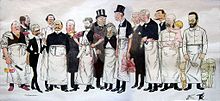Belle Époque
![]()
Belle Epoque is a redirect to this article. For other meanings, see Belle Epoque (disambiguation).
![]()
This article or section needs revision. More details should be given on the discussion page. Please help improve it, and then remove this tag.
Belle Époque [bɛleˈpɔk] (French for "beautiful epoch") is the term for a period of about 30 years at the turn of the 19th and 20th centuries, mainly in Europe. It is most commonly referred to as the period from 1884 to the outbreak of World War I in 1914. For the period before the turn of the century, the term fin de siècle ("end of the century") is also commonly used.

The professors of the medical faculty of Paris. Adrien Barrère, 1904

Poster motif Mayol et sa troupe (Engl. Mayol and his troupe, Adrien Barrère, ca. 1911)
Some general conditions
The Franco-Prussian War of 1870/71 was followed by an unusually long period of peace. It was the basis for a significant upswing of economy and culture in the European core countries Great Britain, France, Germany and Austria-Hungary.
The second wave of the Industrial Revolution acted as a major driving force, with a focus on the chemical industry, electrical engineering, the steel industry and transport. New or larger urban agglomerations grew up at the sites of the factories. This created particular health problems, but also new approaches to solving them. Medicine and hygiene made progress, infant mortality declined, life expectancy increased. Attitudes to work changed. In industry, manufacturing processes were rationalised through the division of labour, work became more monotonous but no less strenuous. Labour organised itself into trade unions and political parties, the predecessors of the Parti Socialiste (PS) in France, the Labour Party in England, the SPD in Germany and the SDAP in Austria. These organizations, despite some setbacks, gained increasing influence in their home countries by 1914. Disadvantages in working life were at least partially offset by a general increase in earnings, in which the workers themselves also had a - relatively small - share; incomes at times rose much faster than consumer prices.
International appearance
Due to the already well-developed transport networks and falling fares, the increased leisure time (of the middle classes) and the increased financial capacities, pleasure travel became more and more attractive. Popular destinations included the World's Fairs (beginning in London in 1851). A particularly impressive exhibition took place in Paris in 1889: The Eiffel Tower was the sensation; this could only be built through the production of steel.
More and more international federations were also founded and the number of international scientific conferences increased significantly. In addition, the first modern Olympic Games were held in Athens in 1896 with great success.
Questions and Answers
Q: What is La Belle Époque?
A: La Belle Époque was a period of Western history that lasted from the end of the Franco-Prussian War in 1871 to the outbreak of World War I in 1914. It was a time of optimism, peace, economic prosperity, and technological, scientific, and cultural innovations.
Q: What events marked the beginning and end of La Belle Époque?
A: The beginning of La Belle Époque was marked by the end of the Franco-Prussian War in 1871 and it ended with the outbreak of World War I in 1914.
Q: How did people view this period?
A: People viewed this period as a "Golden Age" due to its contrast with the horrors experienced during World War I.
Q: In which countries did La Belle Époque overlap with other eras?
A: In the United Kingdom, it overlapped with late Victorian era and Edwardian era; Germany - William I, Frederick III and Wilhelm II; Italy - Victor Emmanuel II, Umberto I and early reigns Victor Emmanuel III; Russia - Alexander III and Nicholas II; United States - Gilded Age (1870s–1900s); Brazil - Paraguayan War; Mexico - Porfiriato; Japan - Meiji period.
Q: What were some accomplishments during this time?
A: During this time there were many technological, scientific, and cultural innovations. The arts flourished in Paris and elsewhere around Europe resulting in masterpieces being created for literature, music theatre, visual art etc.
Q: Who named this period “La Belle Epoque”?
A: This period was named after an event that occurred during this time frame but it is not specified who exactly named it “La Belle Epoque”.
Search within the encyclopedia